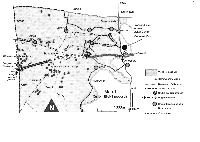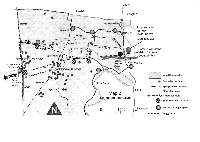So, what should be done at Stonehenge?
From: Rescue News 88 (Autumn 2002) On the day 'a new dawn for Stonehenge' was announced by English Heritage (31 July 2002), the BBC Today Programme's 'seven wonders of Britain' survey placed Stonehenge, in the full light of its present degradation, second after the Palace of Westminster; and a speaker on the programme named Twyford Down one of the 'seven horrors of Britain'.
Those attending Stonehenge's 'new dawn' launch learned that the Heritage Lottery Fund Board (HLF), principally concerned about public access and aware of smouldering unease about the A303 road proposals, has granted £1.2m to help carry forward development work on a project it sees as not yet having reached a satisfactory solution. Anthea Case, HLF Director, emphasised that full support, with a £25m grant towards the provision of visitor-facilities and access, would not be confirmed until various issues were resolved, including ministerial decisions on the A303 following Public Inquiry. Their press release said:
The visitor-access proposals
It is envisaged that, having passed through an attractive new visitor-centre (VC) at Countess, visitors should move 'seamlessly' into the WHS landscape. But most of those arriving by coach (some 35 per cent of visitors p.a.) would be driven in their own coaches along the A303 (via two grade-separated junctions and a tunnel), to a large coach park on the archaeologically sensitive hilltop at Fargo, west of the henge, whence they could walk to the Stones and back (c.20min each way).
Only those arriving at the VC in cars would generally be expected to move 'seamlessly' from the building: under Countess Road (A345) and across the fields to King Barrow Ridge � in petrol-driven buses.
The single-track bridleways, characteristic of this open landscape and a valued local amenity, would be surfaced and widened to accommodate the buses as well as cyclists, walkers and riders. Some 1.3km of new road would be constructed east of King Barrow Ridge, over sensitive archaeological ground (including the ancient Avenue), to hide the sight of the buses from Stonehenge.
There would be choices of three or more drop-off and pick-up points on this eastern side of the WHS, and a 20-minute short walk to the henge; but on the spot access to the Stones would remain restricted for everyone.
Buses for non-coach visitors would also run to and from Fargo via the A303. A local, commercially-run hopper-bus service to WHS perimeter locations might attract the relatively few visitors preferring not to travel there in their own cars, though residents are sceptical about its viability. There would be cycle routes along roads and byways.
Looking at the options proposed, it is clear that the majority
of visitors (who are likely to want to get to Stonehenge and back in a
short time) would have few choices of route and, on rainy days, possibly
not even a glimpse of the Stones. There would be a new road, and a large
coach park at Fargo in sensitive landscape. The use of petrol-driven vehicles
and public highways by a high proportion of visitors following arrival
at the VC would also be environmentally unsustainable.
A better alternative
1. Getting the roads framework right is vital to an holistic solution, for both conservation and management and also for visitor-satisfaction.
In May 2002 archaeologists and NT representatives met EH and Highways Agency personnel and engineers preparing the A303 scheme Environmental Statement, to discuss locations for long-bored tunnel portals. Financial cost limitations aside, there was general agreement that a c.4.5km bored tunnel should, ideally, extend from east of the ancient Avenue to beyond the western boundary of the WHS, in order best to protect its landscape and archaeology. Preliminary drawings have been produced on this basis. This is the sort of road scheme we should be looking at.
2. Costs. The cost of bored tunnelling is now estimated at around £50m per km (Automobile Association leaflet, Going Underground: Tunnels: What role in town and country? (June 2001)). The figure is an average obtained from European tunnelling projects, including bored tunnels (AA Motoring Policy Unit, pers.comm.). A 4.5km bored tunnel for Stonehenge might therefore cost in the region of £225m, roughly a quarter less than estimated only four years ago. Cost benefit analyses are, of course, not conducted in simple money terms and we should expect these to reflect the very high 'heritage' value to be placed upon this WHS.
3. As to the visitor-centre site, local residents fear congestion arising from visitor-centre traffic exiting on to Countess Road. Their logical preference is for a VC west, rather than east, of Countess Roundabout, with immediate access to the WHS, possibly incorporating Countess Farm buildings.
Even if the VC is at Countess East, could direct egress (at least) on to Countess Roundabout be made from Countess West?
4. Modification of bridleways for 'internal' visitor-transit and an unattractive coach journey via highways to Fargo ought not to be necessary.
Could a route from the VC be designed to pass, via Countess West, parallel to and almost alongside the A303, then up and over a new A303 tunnel entrance sited within or near the existing road cutting west of Countess? Could such a route, perhaps formed by widening the present A303 cutting, also partly double as a relief road for highway traffic during construction of a long-bored A303 tunnel? The new road would be partly over damaged surfaces and fairly well concealed. On the above-ground, down-graded surface of the A303, visitors could proceed, ideally via an almost silent 'eco-friendly' transit system, to King Barrow Ridge for walks to the henge -- or elsewhere -- along old road surfaces or over grassland.
Extension of the internal visitor-transit route along the 'old' A303, up the A360 and A344 to Fargo would, if the A303 tunnel emerged west of Longbarrow Crossroads, provide an attractive journey for all. Practicable opportunities for short- and medium-length walks, criss-crossing the WHS would be greatly extended and wider use of the landscape managed and ensured. Stonehenge could be seen from the bus if it rained.
School parties and others with limited time, wishing to obtain maximum educational benefit, could descend and alight at key sites: King Barrow Ridge, for an overall view of the landscape and the Avenue; Byway 12 or Longbarrow Crossroads, for the Normanton Down or Winterbourne Stoke barrows; Fargo, for the Cursus and henge.
Such a scheme offers flexibility and no further threat to the archaeological landscape. New footpaths and the downgrading of byways are already proposed; quiet motorised 'internal' traffic would be confined to the old highways.
The WHS Management Plan advocates removal of motorised traffic (apart from vehicles for agriculture and the less able-bodied) from the 'core area' in the medium to long term (10-30 years; Table 2, Objective 9). The scheme suggested above would permit immediate exclusion of vehicular traffic at less busy times -- perhaps on certain advertised days -- and permanent exclusion in the longer term. Not every bus would need to go to Fargo and managers could adapt the operation to suit seasonal or other conditions. If too many were walking to the henge from the nearest drop-off points, they could be used alternately, only sometimes, or not at all.
No satisfactory internal transit route would be possible with a short
A303 road tunnel. Educational visits to the Winterbourne Stoke barrow group,
for example, would be interrupted by the presence of a dual-carriageway
underpass and grade-separated junction close by; while walkers, riders
and cyclists in the wider WHS would sooner or later have to see, hear,
cross or proceed alongside road cuttings and dual carriageways. Traffic
noise would still be heard at Stonehenge.
Conclusion
In short, current proposals for the A303 and visitor-access are environmentally unsustainable and involve permanent damage to the landscape. From the outset, they limit options for enjoyment of the WHS by the majority of visitors -- especially coach-tourers, including students and schoolchildren. There is little scope for variation or withdrawal of access in the medium to longer term. Necessary provision of vehicular access all the way to the henge in 'buggies' or buses for the less able-bodied and their companions -- possibly some 20 per cent of visitors -- means that vehicular traffic will anyway continue in the 'core area'.
The Today Programme's survey suggests that today's visitor, unprompted to consider otherwise, is content with the present arrangements at Stonehenge. Many others, driving past on the A303, simply value the view. Any improvement should be perceived to be and experienced as the best possible for visitors and the WHS itself. Nothing less should satisfy those nationally and internationally responsible for implementation of the WHS Management Plan.
Will our Government rise to the real challenge of Stonehenge? An holistic
approach is urgently needed for this iconic site. Starting with the roads,
something very much better than a short tunnel for the A303 is fundamental
to getting things right. Instead of saying 'It can't be done!', let us
now begin to ask 'How can it be done?'
Kate Fielden
September 2002
Maps
Click the small pictures for larger ones (the large pics are about 270K GIF files).

Map 1: EH/NT scheme with short A303 tunnel (Prepared by Peter Goodhugh)

Map 2: Suggested alternatives with long bored A303 tunnel (Prepared
by Peter Goodhugh)
